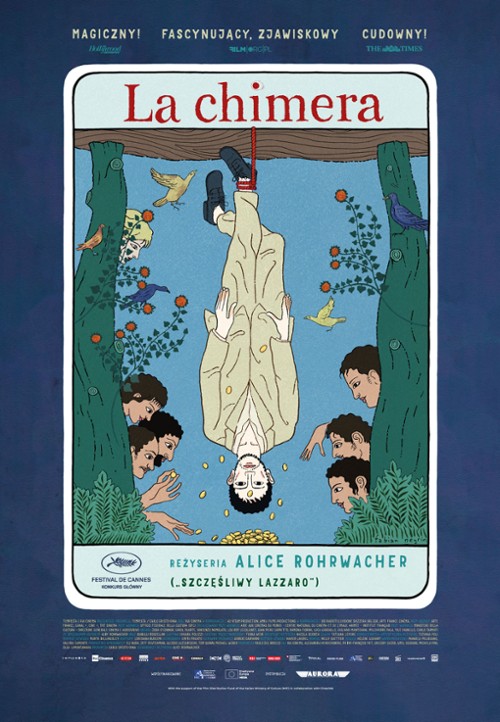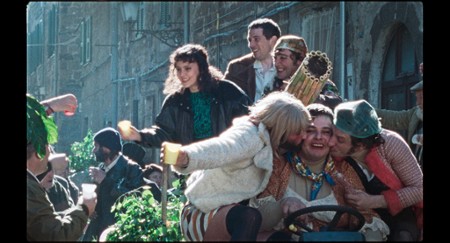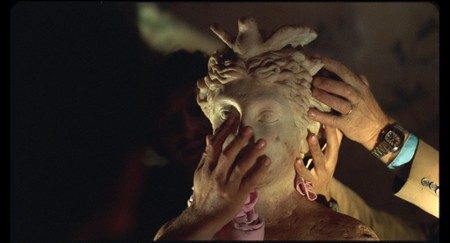The leader of the Tombarola dealers in the valuable finds is Arthur (Josh O'Connor), whom we meet just after his prison term. The Englishman, like the hero of “Happy Lazzaro,” is chosen by the director as the chosen one who carries within him a magical element. The thief, like the human treasure detector, has an extraordinary sensory ability to communicate with the afterlife. Due to his unique talent and tragic past, Arthur is doomed to constantly wander. Like Lazaro, he is like a tragic figure suspended between the temporal and spiritual worlds. Unlike the Divine Fool, he does not have crystalline morality, although his actions do not stem from a desire to make money. The hero suffers from lost love – only upon contact with the past does he feel the touch of his beloved Benjamin again. In his tattered linen shirt and dirty jacket, he resembles a relic discovered in modern times.
The Etruscan heritage of La Chimera, untouched by human eyes, is not waiting to be discovered. For thousands of years, the dead have held out hope of eternal life in sacred underground passages and chambers. Without their precious keepsakes, how could those who died go to heaven? In an unforgettable scene that is a violation of the desecration of a tomb, Rohrwacher pays tribute to the great lost beauty. The conflict between the sacred and the profane highlights human desires and obsession with destruction. Hypnotized by the holy place, if he can, Arthur will remain underground forever and perhaps find a strange spiritual peace among the dusty ruins. In a tombarola song that plays in your ears for hours, a gang member asks the audience to understand: “It's no use judging them,” because the gravediggers are only “a drop in the ocean” of the injustice surrounding them. In fact, by showing the motives of the various thieves, just like the creators of Italian neorealism, the director highlights the flaws of the system that condemns the poor to misery. Even Arthur and his friends, although they were able to make a fortune from their spoils, became victims of the exploitation of the walls. Discoveries hidden from human eyes will be exposed to the sly gaze of the rich, only to be admired in the privacy of their villas and bedrooms. The circle only seems to be closing – Etruscan treasures will likely remain out of reach for ordinary mortals until they finally reach Italian museums. There, in one day, more people will see them than ever before.
As in her previous work, the Italian artist brings together two worlds – noble nature and greedy industry – in contrast. Ignorant, consumer-driven entrepreneurs build power plants and factories on the ruins of history, unaware of the spiritual (and economic) wealth that lies just a few meters beneath their feet. Rohrwacher indicates the constant clash between two different realities by changing the screen format, shooting “La Chimera” once on 35mm and other times on 16mm. The narrower the frame becomes, the more the story seems to be immersed in the past, giving it a fantastical and dreamlike aura. Thanks to the smooth editing, the play with texture, and therefore with the temporal layer of the film, sometimes seems imperceptible, encouraging the viewer to watch it again to discover more hidden meanings. In consciously experimenting with the film's material, the director finds room for elements of slapstick and breaking the fourth wall, bringing her to a whole new level of engaging storytelling.
The Italian creator, focusing on the conceptual perfection of the image, does not lose sight of his characters and, most importantly, the main theme of “La Chimera” – memory. Flora, Benjamin's mother (played by cinema icon Isabella Rossellini), cannot come to terms with the past, and lives in a dilapidated palace forgotten by history. She is still waiting for the return of her daughter, who in the eyes of both the experienced woman and Arthur symbolizes the honorary “chimera.” When the hero visits the mother of his former love, he meets her new guardian – Italy (Carol Duarte); A young woman of innocent, boyish beauty, dressed in floral patterns, represents the glow of the coming future, for which man does not yet seem ready. However, the fates of Arthur and Italy do not intersect without reason. It also turns out that the temperamental heroine is a vagabond searching for her place on earth. Characters who get along without words help each other look at life from a new perspective. A nearby abandoned railway station will be given new life under the leadership of Italy and the local women's community. The heroines' sisterhood and cooperation gain strength when Rohrwacher invokes the matriarchal context of indigenous history—“If the Etruscans were still here, there would be no masculinity in Italy”—and he defiantly and humorously puts it in the mouth of one of the heroes. The heroines wonder what would happen if, instead of plundering the Etruscans, Italy had followed the example of their ancient sciences and arts.
After watching “La Chimera,” what lingers longest in the memory are the dreamlike visions of Arthur, steeped in magical realism, whose moral dilemmas (and even the hero’s colonial origins themselves) provoke the viewer’s musings about cultural appropriation or selective memory, which is convenient for history. In Rohrwacher's works, the guardians of the past and keen observers of the protagonist's fate are birds, by whose flight, the Etruscans believed, fate could be read. The peacock that adorns the frescoes, the owls that watch during nighttime plundering, and the doves that soar above the heroes' heads, accompany Arthur on his hypnotic journey, leading him, like Ariadne's thread, to what the future has planned. Regardless of what awaits the protagonist, Alice Rohrwacher advises everyone to seek out this seemingly elusive “chimera” and not give up Orphic hope. In a transcendent story of man's climb to the limits of imagination, the director restores faith in the original illusion of cinema – and I'm not exaggerating when I say – while ascending to the Olympus of her own creativity.

“Amateur social media maven. Pop cultureaholic. Troublemaker. Internet evangelist. Typical bacon ninja. Communicator. Zombie aficionado.”











